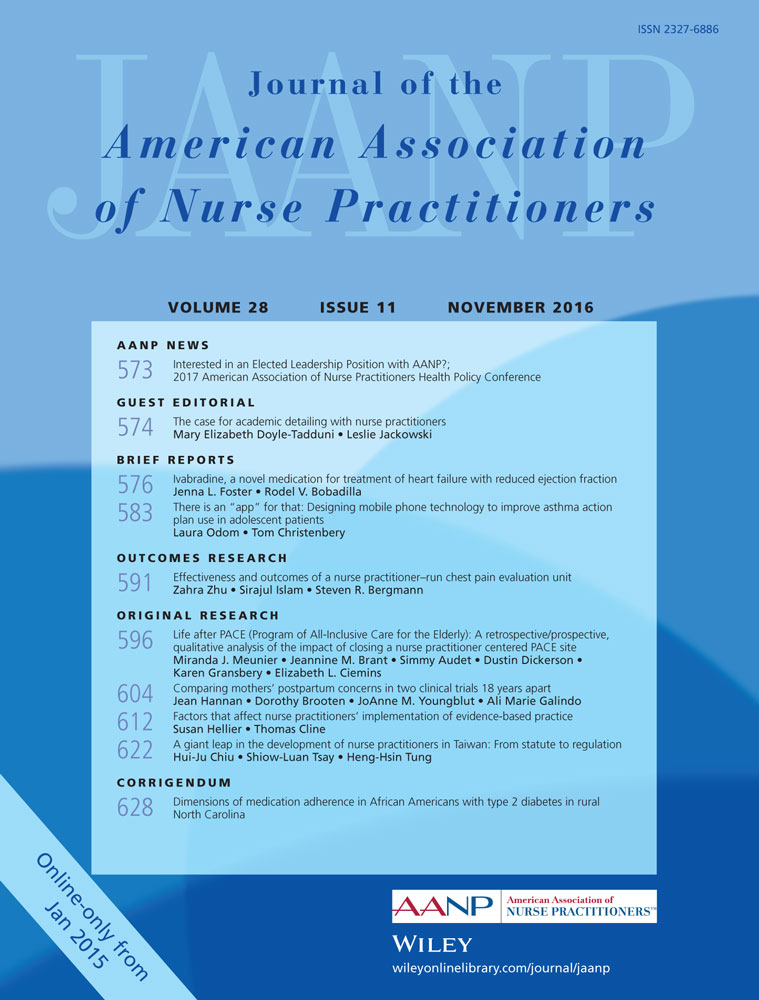Dimensions of medication adherence in African Americans with type 2 diabetes in rural North Carolina
In Stephen Blackmon, Laham, Taylor, and Kemppainen (2016), the authors have requested corrections to the following errors and omissions in their article. All authors have agreed to these corrections and apologize for the errors.
The Morisky Medication Adherence Scale (MMAS) used in this research should have been clarified as the MMAS 8-question version and is properly referred to as MMAS-8. This corrected abbreviation should replace the existing use of MMAS throughout the text.
On page 481, the following sentence is lacking significant references:
To assess behaviors associated with adherence to diabetes medication regimens in a practical and effective manner, the current study used the eight-item Morisky Medication Adherence Scale (MMAS; Morisky, Ang, Krousel-Wood, & Ward, 2008).
The corrected sentence should read:
To assess behaviors associated with adherence to diabetes medication regimens in a practical and effective manner, the current study used the eight-item Morisky Medication Adherence Scale (MMAS-8; Morisky, Ang, Krousel-Wood, & Ward, 2008; Krousel-Wood et al., 2009; Morisky & DiMatteo, 2011).
On page 483, the following sentences are incorrect:
The average score for the total sample on the MMAS was 4.42 (SD 1.37), representing an overall pattern of low adherence to diabetic medications (score below 6 = lowest adherence; 6 to <8 = moderate adherence; <8 = highest adherence).
Only three participants (7.0%) had MMAS scores representing high adherence with an average of 9.0 (SD 1.0; see Table 3).
| Morisky Scale Adherence Rating | N (%) | Mean Score | A!c control | Fasting Glucose |
|---|---|---|---|---|
| Low adherence <6 | 27 (62.8%) | 2.7 (1.4) | 8.3 (2.5) | 134.9 (56.4) |
| Moderate adherence 6 - <8 | 13 (30.2%) | 6.7 (0.8) | 7.2 (1.6) | 131.1 (64.6) |
| High adherence 8 or more | 3 (7.0%) | 8.0 (1.0) | 5.7 (2.6)* | 122.0 (36.4) |
- *Only 1 participant had AIc value recorded in the medical record.
- Permission to use the MMAS scales is required. Reproduction and distribution of the MMAS is protected by US copyright laws. A license agreement to use the scale is available from: Donald E. Morisky, ScD, ScM, MSPH, Professor, Department of Community Health Sciences, UCLA School of Public Health, 650 Charles E. Young Drive South, Los Angeles, CA 90095–1772, [email protected].
In contrast, the scores on the 5-point Likert response averaged 1.37 (SD 1.46) suggesting that participants only have difficulty remembering to take all medications “once in a while.”
The corrected sentences should read:
The average score for the total sample on the MMAS-8 was 3.55 (SD 1.8) representing an overall pattern of low adherence to diabetic medications (score below 6 = lowest adherence; 6 to < 8 = moderate adherence; < 8 = highest adherence).
Only three participants (7.0%) had MMAS-8 scores representing high adherence with an average of 8.0 (SD 1.0; see Table 3).
In contrast, the scores on the 5-point Likert response averaged .62 (SD .39) suggesting that participants only have difficulty remembering to take all medications “once in a while.”
Table 3 on page 483 has an incorrect value and is missing the appropriate footnote for the citation and permission information. The corrected table should read:
The following references should have been included in the reference list:
Krousel-Wood, M. A., Islam, T., Webber, L. S., Re, R. S., Morisky, D. E., & Muntner, P. (2009). New medication adherence scale versus pharmacy fill rates in seniors with hypertension. American Journal of Managed Care, 15(1), 59–66.
Morisky, D. E., & DiMatteo, M. R. (2001). Improving the measurement of self-reported medication nonadherence: Final response. Journal of Clinical Epidemiology, 64, 258–263.




